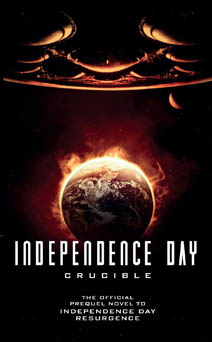
To celebrate the 20th anniversary of “Independence Day” and the release of the sequel, “Resurgence,” this week I’m looking back at the various spinoff comics and novels. All of these spin-off materials were recently released (or re-released, in the case of the old stuff) by Titan Books. Also, check out my reviews of “Independence Day” and “Independence Day: Resurgence.”
If “ID4” is “Star Wars” and “ID:R” is “Return of the Jedi,” then Greg Keyes’ novel “Crucible” (May, paperback) is “The Empire Strikes Back.” It doesn’t have a plot of its own, but rather it brings the characters from the first movie up to the point of the second movie, and it gives the backstories of the new “ID:R” characters.
Keyes, who I knew as a strong character writer from his three “Star Wars: The New Jedi Order” novels, shows that trait again. The “ID4” films feature likable people with colorful personalities, but they don’t always have deep arcs. “Crucible” makes up for that by giving depth to Jake Morrison, Dylan Dubrow-Hiller, Patricia Whitmore and Charlie Miller. We see how Jake takes fellow orphan Charlie under his wing as a surrogate kid brother, and the book culminates with the flying incident that causes Dylan to hate Jake’s guts as the sequel movie begins.
I thought it somewhat odd that “ID:R” didn’t play up a love triangle with Jake, Dylan and Patricia. Indeed, Dylan and Patricia hardly have any scenes together, although it is implied that they have been lifelong friends ever since being scared together in the Area 51 bunker in the first movie. “Crucible” does give us that love triangle, though, as Dylan is somewhat jealous of Jake for catching Patricia’s interest. At the point where Dylan begins to see Patricia as more than a friend, he notes that “she didn’t even look the same” to him anymore, a line that doubles as a nod to (or jab at) the recasting. The Jake-Dylan rivalry also extends to flying the new gravity-drive fighter jets, with the North American slot in the Earth Space Defense’s Legacy Squadron on the line.
The biggest missing element of “ID:R” is, of course, the absence of Will Smith’s Steven Hiller, so it’s refreshing to see him as a loving father to Dylan who still thinks he’s “all that,” as Jasmine puts it. Keyes nails Hiller’s speaking style; I can see Smith acting out these lines in my mind’s eye. The same holds true for Jeff Goldblum’s David Levinson, who becomes the science director of the ESD after resisting the role for several years.
Keyes artfully chronicles Hiller’s tragic 2007 death in a training mission that somewhat calls to mind the Apollo 1 fire. He doesn’t describe the incident in real time, but just shows the build-up and aftermath (perhaps the “ID:R” novelization tells of the event more specifically). The ESD must push things a bit beyond safety margins, in this case not because of a race against another country, but to maintain funding from the world’s taxpayers. There also is, of course, a sense of urgency because the aliens could return at any time.

While Hiller’s death is briefly mentioned in the movie, “ID:R” leaves a viewer wondering what happened to David’s wife, Connie. Since David has a new love interest in the movie – symbologist Catherine, whom he meets in this book – one might think he and Connie drifted apart yet again. Here we learn that she died in a car accident.
A lot of the action in “Crucible” comes from ESD test flights, but there is a smidgen of alien action. Ingeniously, Keyes – no doubt working with Dean Devlin and Roland Emmerich – devises the notion that one of the 36 city destroyers landed in Africa within the boundaries of a militant banana republic ruled by a madman. Umbutu won’t allow outsiders to access the ship, and his men continue fight off aliens for a full decade. Umbutu’s son, Dikembe, gets a wild backstory here about working up the will and a way to overthrow his increasingly insane father.
Although Keyes doesn’t bring it to the surface, “Crucible” also works as a sci-fi future (or technically, alternate) history, bringing us from the War of 1996 up to the 2016 of “Resurgence.” (As a nice bonus, a chronology of the saga is included at the back of the book.) As seen in the film, military technology has advanced significantly in two decades thanks to reverse-engineering of tech salvaged from the city destroyers’ wreckage. We mainly just know about the gravity drives; the author misses an opportunity to do direct tie-ins with “War in the Desert,” which featured a lot more tech, including plasma guns and vehicles that can be controlled by the occupants’ minds. And while we’re told that the U.S. government possesses alien corpses and captives, we don’t see any of this; it seems our knowledge of how the aliens think and behave hasn’t advanced much beyond what Dr. Okun learned in “Silent Zone.”
The dark undercurrent of both “Crucible” and “Resurgence” is that the military has hoarded the alien technology, purposely keeping it from the citizenry. Even though Stephen Bell, Whitmore’s VP after the War of the 1996 (which killed the previous veep off-screen), says he’s in favor of leaving non-military applications of the alien tech to the private sector, it seems that tech doesn’t get past the military’s doors. The movie features cars and buses and cellphones exactly like those of the real-world 2016, even as the Earth military uses gravity-drive ships and has a moon base, not to mention – as we learn in “Crucible” – additional outposts on Mars and some satellites of Saturn!
This is to say nothing of the fact that the U.S. government has rebuilt the White House and the Washington Mall monuments, in the same shapes, but bigger and more extravagantly, and that Air Force One has a gravity drive. The reasoning is that it sends a message of hope to the American people. I wish Keyes and the “ID4” creators would’ve fully embraced the alternate history possibilities here and had the new capital set up in some place that was spared from the 1996 attacks, like Nebraska. At least they make Area 51 into the new Pentagon; indeed, Levinson and the Hiller family live in the new desert town of 51, Nevada. Another missed opportunity is that Levinson doesn’t seem concerned with the lack of proliferation of clean energy across the globe; although he grumbles about it occasionally, he’s become a G-man.
As noted, Hiller’s test flight is a necessary publicity stunt because taxes are sky-high in order pay for the reconstruction and the ginormous military, and the people must continue to be convinced that the robust defense is crucial. That’s the odd thing about the “Independence Day” franchise. Humanity has de-emphasized nationalities, races, creeds and borders since its near-extermination in 1996, yet a different class division has arisen between the political/military class and the civilian class.
This division doesn’t manifest itself in the form of a clash, largely because there are no prominent civilian characters in “Crucible” (as with “Resurgence”). It makes the book play somewhat like an old Heinlein novel, where a pro-military stance is a given. For every “Crucible” character, the path to success and a good life is through the military or the government. Aside from one throwaway line about how the average person is hurting under the tax burden, Keyes doesn’t seem to recognize the serious conflict among two classes of humanity that is bubbling under the surface.
Interestingly, Whitmore does recognize that a war would more firmly unite humanity once again – although he hastily adds that he doesn’t desire war. Of course, in “Resurgence,” the return of the aliens pushes any possible inter-human conflict to the background as it seems to justify the creation of a military-dominated culture. “Aliens vs. humans” makes for a better blockbuster experience, but the idea that sheer survival has a massive economic and cultural cost is too subtle of an undercurrent in this spin-off novel, especially since there is a rich parallel to be had with Real World 2016. The “ID4” franchise would do well to tease out those ideas a bit more if it wants to grow.

